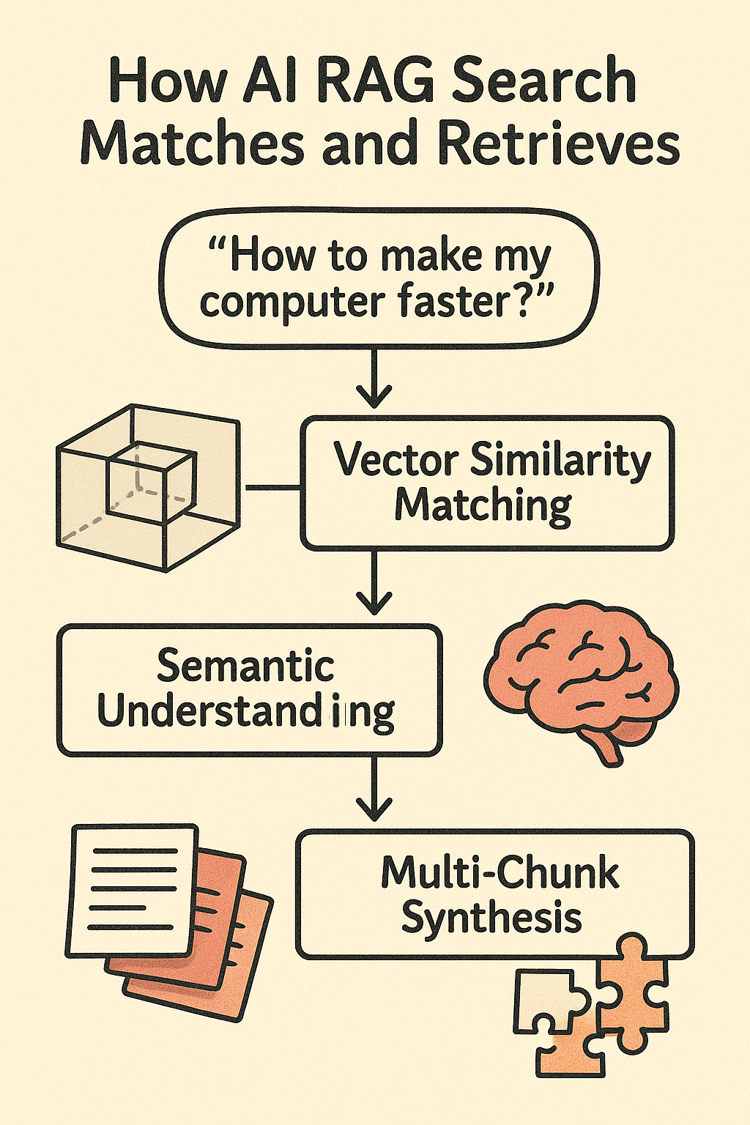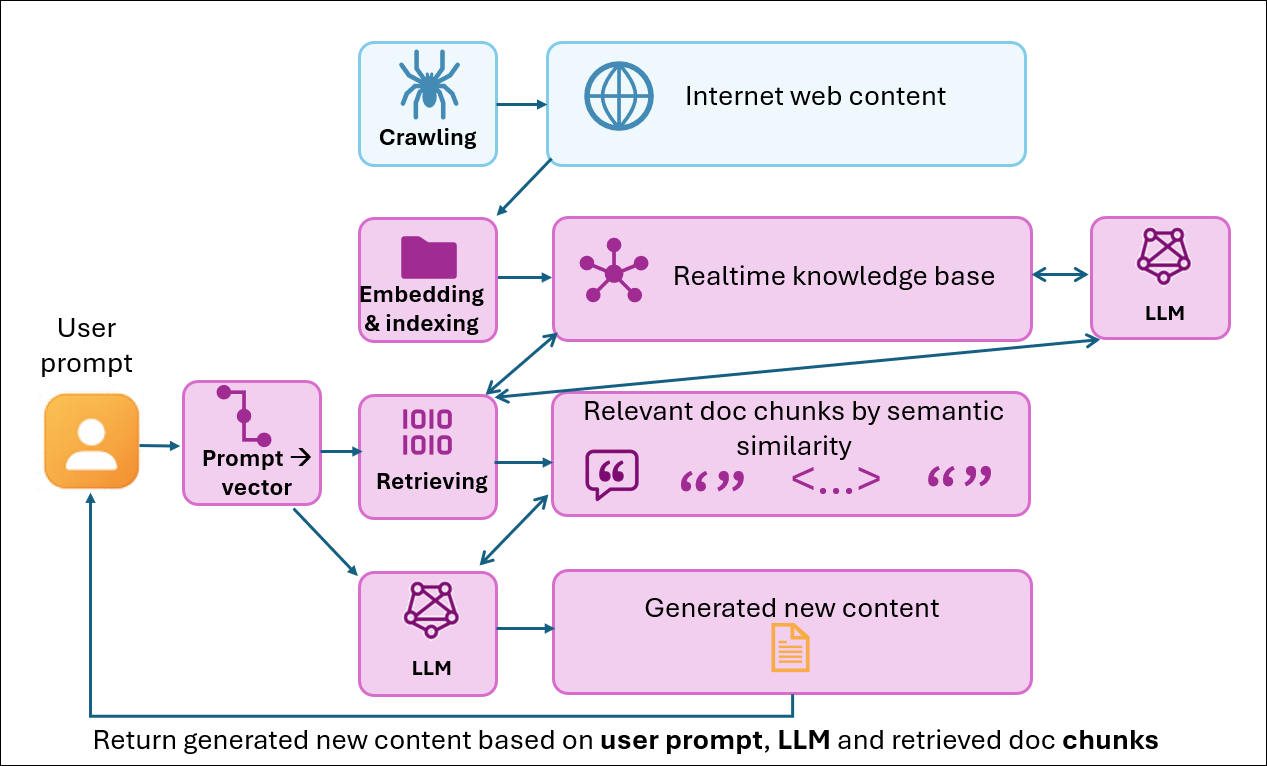In my previous posts, we’ve explored how AI systems index content through semantic chunking rather than keyword extraction, and how they understand user intent through contextual analysis instead of pattern matching. Now comes the final piece: how AI systems actually retrieve and synthesize content to answer user questions.
This is where the practical implications for content creators become apparent.
The Fundamental Shift: From Finding Pages to Synthesizing Answers
Here’s the key difference that changes everything: Traditional search matches keywords and returns ranked pages. AI-powered search matches semantic meaning and synthesizes answers from specific content chunks.
This fundamental difference in matching and retrieval processes requires us to think about content creation in entirely new ways.
Let’s see how this works using the same example documents from my previous posts:
Document 1: “Upgrading your computer's hard drive to a solid-state drive (SSD) can dramatically improve performance. SSDs provide faster boot times and quicker file access compared to traditional drives.“
Document 2: “Slow computer performance is often caused by too many programs running simultaneously. Close unnecessary background programs and disable startup applications to fix speed issues.“
Document 3: “Regular computer maintenance prevents performance problems. Clean temporary files, update software, and run system diagnostics to keep your computer running efficiently.“
User query: “How to make my computer faster?“
How Traditional vs. AI Search Retrieve Content
How Traditional Search Matches and Retrieves
Traditional search follows a predictable process:
Keyword Matching: The system uses TF-IDF scoring, Boolean logic, and exact phrase matching to find relevant documents. It’s looking for pages that contain the words “computer,” “faster,” “make,” and related terms.
Authority-Based Ranking: PageRank algorithms, backlink analysis, and domain authority determine which pages rank highest. A page from a high-authority tech site with many backlinks will likely outrank a smaller site with identical content.
Example with our 3 computer docs: For “How to make my computer faster?“, traditional search would likely rank them this way:
- Doc 1 ranks highest: Contains the exact keyword “
faster” in “faster boot times” plus “improve performance“ - Doc 2 ranks second: Strong semantic matches with “
slow computer” and “speed issues“ - Doc 3 ranks lowest: Related terms like “
efficiently” and “performance” but less direct keyword matches
The user gets three separate page results. They need to click through, read each page, and synthesize their own comprehensive answer.
How AI RAG Search Matches and Retrieves

AI-powered RAG systems operate on entirely different principles:
Vector Similarity Matching:
Rather than matching keywords, the system uses cosine similarity to compare the semantic meaning of the query vector against content chunk vectors. The query “How to make my computer faster?” gets converted into a mathematical representation that captures its meaning, intent, and context.
Semantic Understanding:
The system retrieves chunks based on conceptual relationships, not just keyword presence. It understands that “SSD upgrade” relates to “making computers faster” even without shared keywords.
Multi-Chunk Synthesis:
Instead of returning separate pages, the system combines the most relevant chunks from multiple sources to create a comprehensive answer.
Example with same query: Here’s how AI would handle “How to make my computer faster?” using the chunks from my first post:
The query vector finds high semantic similarity with:
- Chunk 1A: “
Upgrading your computer's hard drive to a solid-state drive (SSD) can dramatically improve performance.“ - Chunk 1B: “
SSDs provide faster boot times and quicker file access compared to traditional drives.“ - Chunk 2B: “
Close unnecessary background programs and disable startup applications to fix speed issues.“ - Chunk 3B: “
Clean temporary files, update software, and run system diagnostics to keep your computer running efficiently.“
The AI synthesizes these chunks into a comprehensive answer covering hardware upgrades, software optimization, and maintenance—drawing from all three documents simultaneously.
Notice the difference: traditional search would return Doc 1 as the top result because it contains “faster,” even though it only covers hardware solutions. AI RAG retrieves the most semantically relevant chunks regardless of their source document, prioritizing actionable solutions over keyword frequency. It might even skip Chunk 2A (“Slow computer performance is often caused by...“) despite its strong keyword matches, because it describes problems rather than solutions.
The user gets one complete answer that addresses multiple solution pathways, all sourced from the most relevant chunks regardless of which “page” they came from.
Why This Changes Content Strategy

This retrieval difference has profound implications for how we create content:
Chunk-Level Discoverability
Your content isn’t discovered at the page level—it’s discovered at the chunk level. Each section, paragraph, or logical unit needs to be valuable and self-contained. That perfectly written conclusion paragraph might never be found if the rest of your content doesn’t rank well, because AI systems retrieve specific chunks, not entire pages.
Comprehensive Coverage
AI systems find and combine related concepts from across your content library. This requires strategic coverage:
Instead of trying to stuff keywords into a single page, create focused pieces that together provide comprehensive coverage. Rather than one “ultimate guide to computer speed,” create separate pieces on hardware upgrades, software optimization, maintenance, and diagnostics.
Synthesis-Ready Content
Write chunks that work well when combined with others—provide complete context by:
- Avoiding excessive pronoun references
- Writing self-contained paragraphs and sections
The Bottom Line for Content Creators
We’ve now traced the complete AI search journey:
- How AI indexes content through semantic chunking (Post 1)
- Understands user intent through contextual analysis (Post 2)
- Retrieves and synthesizes content through vector similarity matching (this post)
Each step reinforces the same content recommendations:
- Chunk-sized content aligns with how AI indexes and retrieves information
- Conversational language matches how AI understands user intent
- Structured content supports AI’s semantic chunking and knowledge graph construction
- Rich context supports semantic relationships that AI systems rely on, including:
- Intent-driven metadata (audience, purpose, user scenarios)
- Complete explanations (the why, when, and how behind recommendations)
- Relationships to other concepts and solutions
- Trade-offs, implications, and prerequisites
- Comprehensive coverage works with how AI synthesizes multi-source answers
AI technology is rapidly evolving. What is true today may become outdated tomorrow. AI may eventually become so advanced that we don’t have to think specifically about writing for AI systems—they’ll accommodate how humans naturally write and communicate.
But no matter what era we’re in, the fundamentals of creating high-quality content remain constant. Those recommendations we’ve discussed are timeless principles of good communication: create accurate, true, and complete content; provide as much context as possible to communicate effectively; offer information in digestible, bite-sized pieces for easy consumption; write in conversational language for clarity and engagement.
Understanding how current AI systems work simply reinforces why these have always been good practices. Whether optimizing for search engines, AI systems, or human readers, the goal remains the same: communicate your expertise as clearly and completely as possible.
This completes my three-part series on AI-ready content creation. Understanding how AI indexes, interprets, and retrieves content gives us the foundation for creating content that thrives in an AI-powered world.





